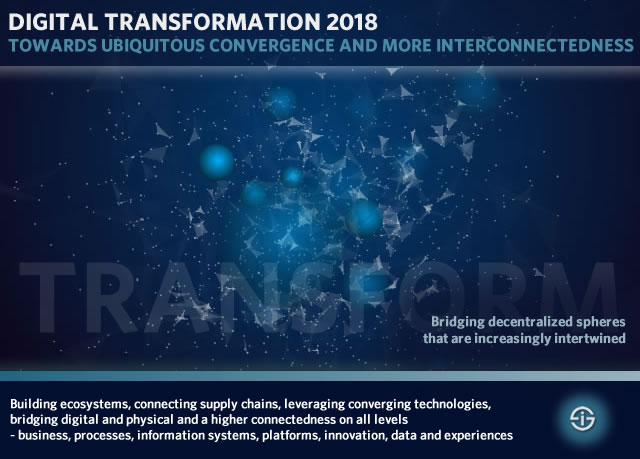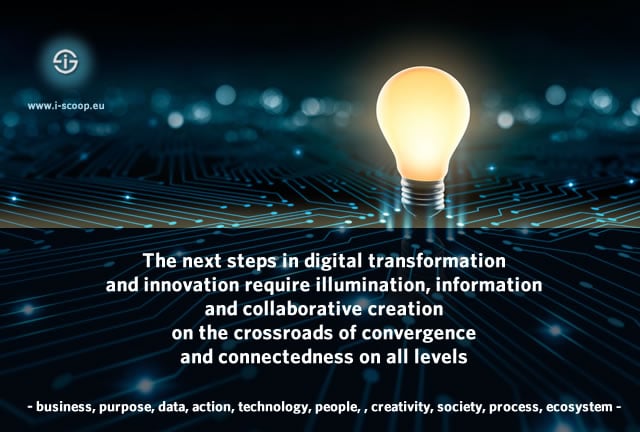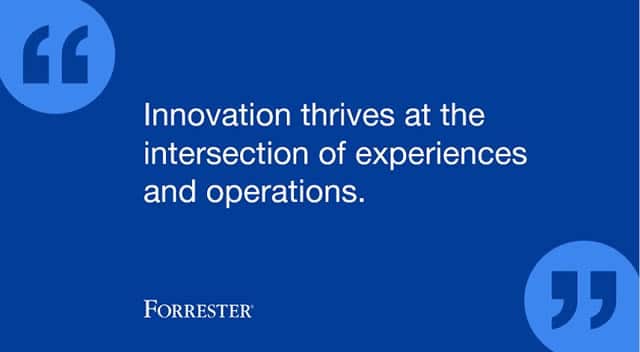A large number of organizations have digital transformation at the top of their agenda for 2018 and beyond. It’s what many surveys tell us, what we hear when talking with executives and when working with companies – and it’s of course not the first time. In this article we kick off a digital transformation 2018 series with a look at some evolutions and broader findings.
In all three cases mentioned above (research, what people say and what companies do) one has to be cautious as digital transformation still seems to mean many different things to many different people: in one corner the more technology-centric view, in the other corner the more strategic and holistic view with transformation as a gradual approach.
One with multiple goals and stages, going beyond digitization and the application of technologies towards innovation and flexibility capabilities to deal with the demands of a highly interconnected real-time economy with a lot of ecosystem building, connecting of supply chains, convergence (IT and OT, the convergence of technologies such as AI, IoT and big data analytics) and bridging of digital and physical (as in IoT indeed) going on.

And then there are some who look at it from the pure customer experience perspective, ‘disruptions‘ or things that really have little to do with digital transformation at all (no, having a new ERP system or a new shiny website or front-end app that remains disconnected from all the rest and the back end doesn’t equal digital transformation).
Digital transformation 2018: putting forecasts in perspective
The most popular approach for articles and research on digital transformation (also known as DX or DT) in 2018 is to list the technologies that will be most important. Technologies do indeed tend to be important in many aspects of digital transformation and people sure like tech trends.
Sometimes we go a bit too far though. Recently we stumbled upon predictions from an obscure new research firm with digital transformation technologies you never heard of and won’t use in the next years to come. It did sound very intelligent though, the names of the technologies that is. More importantly, it’s good to remind that digital transformation is not just about technologies as often said but more about that below when we look at the growing convergences and interconnectedness which essentially is a matter of building many bridges across highly related spheres, the essence of our article on digital transformation strategy.
A second popular approach is to focus on the technologies and solutions that companies need and use today and will increasingly use in the next year(s). Most of them do ring a bell for most people and some are maybe a bit new. A digital transformation 2018 (and 2017) trend is definitely that digital transformation is now used as a term by virtually anyone that sells technologies and solutions (all the way up to things like websites and office equipment). True, IDC does say that digital transformation is the application of third platform technologies but it says more than that, even as in some sponsored pieces we’ve seen that ‘fine print’ being left out, even if it’s key (but doesn’t serve the goal of the customer’s marketing that much).
Despite the “digital” moniker, there is much more to digital transformation than just technology (IDC)
We also do remember that IDC said that “despite the “digital” moniker, there is much more to digital transformation than just technology and defined digital transformation as the continuous process by which enterprises adapt to or drive disruptive changes in their customers and markets (external ecosystem) by leveraging digital competencies to create new business models, products, and services and much more. Well, we didn’t remember to be honest, we looked it up on Google and found it in this 2015 PDF (and then remembered).
Another approach is to look at innovations, sometimes happening but less than one might believe, sometimes more futuristic and sometimes quite relevant with the occasional ‘wow’. A final one we need to mention (there are a lot more) is to let the digital transformation 2018 forecasts fully revolve around one or maybe a few aspects, goals, vertical markets or DX economy trends that are all important but should be seen within the broader picture: customer experience, industrial transformation, the ways we work, the list goes on.
Silos and simplifications – we don’t want them but to be continued
Customer-centricity and the expectations of customers in the broadest sense (workers, partners, buyers, partners, “users”) remain very important as is the customer experience in the broadest sense but they are not alone.
The same goes for other aspects of digital transformation, including the technological ones. When saying which technologies will drive digital transformation in 2018 we really are de facto also creating silos as it looks as if each stands on their one. The best digital transformation technology forecasts and analysis out there (and there is a bunch) connects those dots and shows how companies de facto connect these technology, data, processes, cross-fertilization and whatnot dots to digitally transform in practice – with examples.
Innovation thrives at the intersection of experiences and operations (Forrester)
It becomes worse if you really get real and dive into the realities behind terms such as IoT and so forth. An example: it is relatively easy and obvious that the IoT will become more important and, along with edge computing and artificial intelligence, drives intelligence and action more to the edge.
But in which industries and use cases? And what forms of AI are we talking about? And which of the many IoT technologies and technology layers do we mean? And isn’t the combination of the technological umbrella terms that we see in our digital transformation 2018 technology trend forecasts more important than each set of technologies in a separate and siloed way? Silos are exactly what we don’t want in digital transformation. You also need to look at ecosystems, the impact of changing regulations, well, all the things we’ve been covering since so long in a maybe somewhat simplifying and outspoken way.
Anyway, this introduction is already longer than the average article on the key digital transformation 2018 trends or technologies but we do like to keep hammering on that holistic, connected perspective in which people are (should) also take center stage, along with data turned into intelligence, actions and value, business models and the bridging of digital and physical of course, not forgetting that people don’t want everything digital. Unfortunately, regardless of how dangerous siloed visions and digital transformation forecasts can be, we do need them as you’ll read.
Digital transformation 2018: asking the right people
Many studies ask CEOs about their digital transformation 2018 plans while others focus on CIOs or CDOs and others seem to want to continue digital transformation in the relatively limited scope of the CMO.
That does lead to different answers given the often different views but that too is OK. It is certainly so if you start looking at the digital transformation priorities of CEOs in large multinational firms or specific industries as compared to those of top 100 corporations or smaller companies. But better know what everyone thinks and understand it than to limit ourselves. The opinions of people who actually make it happen in practice such as customer-facing workers are seldom asked. When they occasionally are, there is systematically a discrepancy between how important, for instance, the CEO says customer experience is in his digital transformation 2018 goals and how those people who are working hard in the key areas where ‘customer experience’ happens feel how important it really is in practice.
That’s always a good wake-up call which occurs quite often as reported at previous occasions. Most companies de facto are not really focusing that much on customer experience as they like to believe and innovation isn’t that important either for many companies. It’s like in industrial transformation or Industry 4.0: most still – and will continue to, another digital transformation 2018 prediction – really look at cost savings, automation, internal goals and optimizing efficiency as we now and then call making as much money as possible with as little cost, human labor and efforts as possible.
Silos and simplifications – we need them
Still, we want to look at how things are with regards to digital transformation now and in 2018. In a sense there are few things that are more impossible than doing that. Because the digital transformation strategy of company A strictly speaking looks nothing like that of company B.
That’s why people tend look at aspects, whether they are technologies or specific business processes and so forth in their research as well of course and that also makes total sense as long as we keep that bigger picture in mind. Despite what we now and then read there is no such thing as “THE” digital transformation” as if it were a thing or something you can’t see but spreads, like the flue.
The best thing we see happening with regards to digital transformation is maybe the fact that the narrative around it is changing and more people seem to look at it in a holistic way.

Smart businesses already have their roadmaps and integrated view of course. And it’s not so much about digitally transforming. It’s about business transformation, optimization, innovation and even re-creation and many more -ation’s, enabled through a mix of technologies and key capabilities that are required on multiple levels (skills, agility and much more). However, in order to speak about these and other digital transformation evolutions for 2018 we need to keep our research and forecasts and what not a bit more siloed and simple than we would really want, it’s a challenge for everyone, whether they look at digital transformation technology evolutions or evolving digital transformation projects and goals and whatnot.
Digital transformation 2018: a reminder and lessons
Recently we were very happy to stumble upon a tweet from Forrester Research. It said that digital transformation is not just for customer experience but also about transforming business models. When clicking the link it leads to a page where you can watch a webinar.
We haven’t done so but, in case you still doubted about what the message of the tweet said and want to get the advice from Forrester for free we do recommend you to. And now you also know where that quote above is coming from.

Here is a quote from the landing page: “Digital transformation requires an overhaul of your entire business: from culture to leadership, skills, and even business models.” Whether that means placing technology at the core or something else (there is a lot at the core of digital transformation, like data, the mentioned skills and capabilities, revenues, people, flexibility, actionable intelligence and some darn good innovation skills and creative imagination to move to the right stage for and with your business, customers and so forth) but you get the message: digital transformation is not a thing nor about one thing at it does require a broader perspective, not even with regards to your entire business alone but with regards to the entire ecosystem and context within which your business operates at all relevant levels.
The reason why that tweet made us happy is of course not because Forrester Research before said that it was all – or alone – about the customer experience. But, from the company that is the strongest advocate of customer obsession (wait, they invented the term) it is a good reminder. And, admittedly, it’s always more credible when the likes of Forrester Research remind us now and then.
Aside from saying that maybe 2018 is the year in which companies might have a more holistic and strategic understanding of digital transformation we didn’t really live up to the expectations of the title and text you’ve read if you were looking for digital transformation trends, digital transformation technology evolutions, evolving digital transformation goals, digital transformation projects or digital transformation research on 2018 digital transformation surveys.
However, it is the first of a series. And if we made someone, anywhere at all, think about the importance of that integrated perspective, especially someone who looked at immediate gains or at specific goals or projects alone, it’s mission accomplished. Hopefully the rest of our digital transformation 2018 series will offer more insights once we start covering all the things discussed above and add those follow-up articles as links below.
Do remember convergence and interconnectedness though. The next steps in digital transformation and innovation require illumination, information and collaborative creation on the crossroads of convergence and connectedness on all levels – business models and processes, connected goals, data turned into intelligence into valuable action, technologies, people, creativity, cognitive environments, innovative capabilities, society, platforms, ecosystems, exchanges, decentralized approaches, autonomous and semi-autonomous systems and more.
Obviously in a strategic way. How and why? That’s for later. Just know that some companies are getting there. Those who undervalue the human aspect will ultimately fail as will those who overemphasize the technologies, the internal goals, the siloed efforts and the automation dimensions without moving beyond that. Yet, in 2018 the latter will be by far the largest category.
Top vector: Shutterstock – Copyright: SkillUp – Quote image: Shutterstock – Copyright: phive – Feature image: Shutterstock – Copyright: Robert Kneschke

